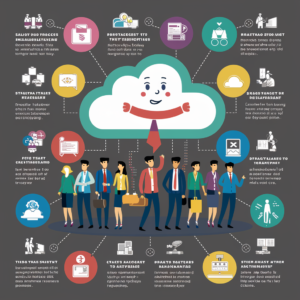Java For Kids
Starting with the basics of Java syntax and control flow, the ebook gradually progresses to more advanced topics such as object-oriented programming, file input/output, error handling, and more. Each chapter is carefully crafted to provide a solid understanding of Java concepts while keeping young readers engaged and motivated.
Introduction:
In today’s dynamic and fast-paced digital landscape, businesses rely on cloud computing services to power their operations, applications, and infrastructure. However, managing and orchestrating cloud resources manually can be time-consuming, error-prone, and inefficient. Cloud orchestration provides a solution by automating the provisioning, configuration, and management of cloud resources and workflows, enabling organizations to achieve greater efficiency, agility, and scalability. In this article, we’ll explore the concept of cloud orchestration and how it helps businesses streamline their operations through automation.
What is Cloud Orchestration?
Cloud orchestration is the process of automating the deployment, management, and coordination of cloud infrastructure, applications, and services. It involves defining workflows, templates, and policies that specify how cloud resources should be provisioned, configured, and scaled to meet the needs of applications and workloads. Cloud orchestration platforms use automation tools, scripting languages, APIs, and declarative configuration files to execute predefined tasks and workflows, enabling seamless integration and coordination across distributed cloud environments.
Key Components of Cloud Orchestration:
- Infrastructure as Code (IaC): Infrastructure as Code is a key concept in cloud orchestration that involves managing infrastructure configurations programmatically using code. IaC tools such as Terraform, AWS CloudFormation, and Azure Resource Manager enable developers to define cloud resources, dependencies, and configurations in code, which can be version-controlled, tested, and deployed consistently across environments.
- Automation Scripts and Templates: Cloud orchestration platforms use automation scripts and templates to define workflows, tasks, and configurations for provisioning and managing cloud resources. These scripts and templates are written in scripting languages like Python, PowerShell, or YAML, and they encapsulate best practices, conventions, and reusable components for infrastructure provisioning and configuration.
- Orchestration Engines: Orchestration engines are the core components of cloud orchestration platforms that execute workflows, coordinate tasks, and manage dependencies across distributed cloud environments. Orchestration engines leverage automation scripts, templates, and APIs to orchestrate the provisioning, configuration, and scaling of cloud resources dynamically based on predefined policies and triggers.
- Workflow Management: Cloud orchestration platforms provide workflow management capabilities to define, visualize, and monitor complex workflows and dependencies. Workflow management tools enable users to create, edit, and execute workflows using a visual interface or declarative configuration files, simplifying the orchestration of multi-step processes and tasks.
Benefits of Cloud Orchestration:
- Automation and Efficiency: Cloud orchestration automates repetitive tasks, reduces manual intervention, and streamlines workflows, improving operational efficiency and productivity. By automating resource provisioning, configuration management, and scaling, organizations can accelerate time-to-market and focus on delivering value to customers.
- Scalability and Elasticity: Cloud orchestration enables organizations to scale resources up or down dynamically in response to changing demand and workload requirements. By automating resource scaling and load balancing, organizations can optimize resource utilization, improve performance, and minimize costs.
- Consistency and Compliance: Cloud orchestration ensures consistency and compliance by enforcing standardized configurations, security policies, and governance controls across cloud environments. By defining infrastructure as code and automating configuration management, organizations can maintain consistency, traceability, and auditability of cloud resources and configurations.
- Agility and Innovation: Cloud orchestration enables organizations to adapt quickly to changing business requirements, experiment with new technologies, and innovate at scale. By automating DevOps workflows, CI/CD pipelines, and application deployments, organizations can iterate faster, deliver value incrementally, and respond to market changes more effectively.
Conclusion:
Cloud orchestration is a powerful approach for automating and streamlining the management of cloud resources and workflows in distributed and dynamic cloud environments. By leveraging infrastructure as code, automation scripts, orchestration engines, and workflow management tools, organizations can achieve greater efficiency, scalability, agility, and innovation in their cloud operations. As businesses continue to embrace cloud computing and digital transformation initiatives, cloud orchestration will play an increasingly critical role in driving operational excellence, cost optimization, and competitive advantage in the cloud era.






